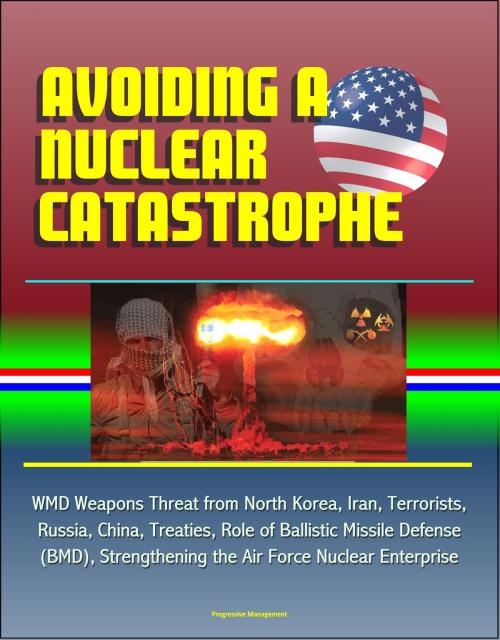Avoiding a Nuclear Catastrophe: WMD Weapons Threat from North Korea, Iran, Terrorists, Russia, China, Treaties, Role of Ballistic Missile Defense (BMD), Strengthening the Air Force Nuclear Enterprise
Nonfiction, History, Military, Nuclear Warfare, Social & Cultural Studies, Political Science| Author: | Progressive Management | ISBN: | 9781370734535 |
| Publisher: | Progressive Management | Publication: | March 19, 2017 |
| Imprint: | Smashwords Edition | Language: | English |
| Author: | Progressive Management |
| ISBN: | 9781370734535 |
| Publisher: | Progressive Management |
| Publication: | March 19, 2017 |
| Imprint: | Smashwords Edition |
| Language: | English |
Professionally converted for accurate flowing-text e-book format reproduction, this report is the summary of the Air Force Counter-proliferation Center (CPC) and Defense Threat Reduction Agency (DTRA) Weapons of Mass Destruction (WMD) Conference, featuring unique commentary on the reduction of the threat posed by nuclear weapons. Contents: Chief Of Staff Vector — Priority Number One * Thinning The Nuclear Threat—Three Elements * The Central Role Of Deterrence * Missile Defense And Deterrence * Scoping And Dealing With The Nuclear Terror Threat * Continuing To Strengthen The Air Force Nuclear Enterprise * The 2010 Nuclear Posture Review * Conclusion
An estimated 35 countries have nuclear weapons, highly enriched uranium, and/or stockpiles of plutonium on their soil. Although four out of every five nuclear weapons that have been built since 1945 have retired from service, the world is still awash in nuclear weapons. Nuclear weapons states now possess around 23,300 such weapons. This is occurring at a time when one such weapon detonated in a major city could have catastrophic human and economic effects. For example, one RAND study estimates that one 10-kiloton weapon explosion in Long Beach, California, could cause 60,000 immediate deaths and up to 150,000 other casualties. Such a detonation would destroy the ports of Long Beach and Los Angeles, causing about 6 million people to evacuate the area to escape fallout, and 2-3 million people to relocate. Such a nuclear catastrophe would contaminate 500 square kilometers and destroy or make uninhabitable up to 600,000 homes. It would also inflict an economic rebuilding cost estimated at one trillion dollars. This could make the 9/11 attacks, however grisly, seem somewhat minor. Yet this would be the consequence of only one nuclear bomb at one major US port. A full-scale nuclear war between two major states, such as the United States and Russia, would have far more catastrophic effects than even a nuclear terror attack. The deaths could reach hundreds of millions in the first exchange.
A first way to thin or reduce WMD proliferation to states and groups of concern is through unilateral and multilateral non-proliferation initiatives. Nonproliferation is accomplished through disarmament treaties, arms control agreements and pacts, various export control regimes, interdiction programs designed to limit illicit trafficking of WMD technology, sanctions, and incentives designed to influence states not to acquire WMDs or to relinquish them. Various other nonproliferation measures abound.
A second means of reducing the threat of WMD-armed adversaries is through counterproliferation military programs that provide one or more of the following: (1) a deterrent against the initiation of war or the escalation of an ongoing conflict; (2) offensive operations or counterforce capabilities to hold at risk, destroy, or capture rival WMD assets; (3) active defenses to prevent effective delivery of WMDs on US or allied targets; and (4) passive defenses that can help protect personnel and assets and get the military back in the fight.
Professionally converted for accurate flowing-text e-book format reproduction, this report is the summary of the Air Force Counter-proliferation Center (CPC) and Defense Threat Reduction Agency (DTRA) Weapons of Mass Destruction (WMD) Conference, featuring unique commentary on the reduction of the threat posed by nuclear weapons. Contents: Chief Of Staff Vector — Priority Number One * Thinning The Nuclear Threat—Three Elements * The Central Role Of Deterrence * Missile Defense And Deterrence * Scoping And Dealing With The Nuclear Terror Threat * Continuing To Strengthen The Air Force Nuclear Enterprise * The 2010 Nuclear Posture Review * Conclusion
An estimated 35 countries have nuclear weapons, highly enriched uranium, and/or stockpiles of plutonium on their soil. Although four out of every five nuclear weapons that have been built since 1945 have retired from service, the world is still awash in nuclear weapons. Nuclear weapons states now possess around 23,300 such weapons. This is occurring at a time when one such weapon detonated in a major city could have catastrophic human and economic effects. For example, one RAND study estimates that one 10-kiloton weapon explosion in Long Beach, California, could cause 60,000 immediate deaths and up to 150,000 other casualties. Such a detonation would destroy the ports of Long Beach and Los Angeles, causing about 6 million people to evacuate the area to escape fallout, and 2-3 million people to relocate. Such a nuclear catastrophe would contaminate 500 square kilometers and destroy or make uninhabitable up to 600,000 homes. It would also inflict an economic rebuilding cost estimated at one trillion dollars. This could make the 9/11 attacks, however grisly, seem somewhat minor. Yet this would be the consequence of only one nuclear bomb at one major US port. A full-scale nuclear war between two major states, such as the United States and Russia, would have far more catastrophic effects than even a nuclear terror attack. The deaths could reach hundreds of millions in the first exchange.
A first way to thin or reduce WMD proliferation to states and groups of concern is through unilateral and multilateral non-proliferation initiatives. Nonproliferation is accomplished through disarmament treaties, arms control agreements and pacts, various export control regimes, interdiction programs designed to limit illicit trafficking of WMD technology, sanctions, and incentives designed to influence states not to acquire WMDs or to relinquish them. Various other nonproliferation measures abound.
A second means of reducing the threat of WMD-armed adversaries is through counterproliferation military programs that provide one or more of the following: (1) a deterrent against the initiation of war or the escalation of an ongoing conflict; (2) offensive operations or counterforce capabilities to hold at risk, destroy, or capture rival WMD assets; (3) active defenses to prevent effective delivery of WMDs on US or allied targets; and (4) passive defenses that can help protect personnel and assets and get the military back in the fight.















